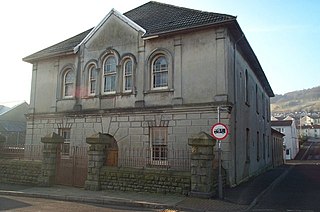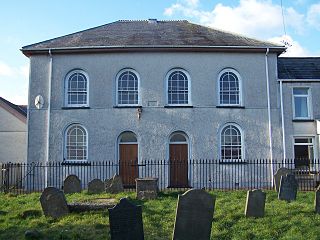
Aberdare is a town in the Cynon Valley area of Rhondda Cynon Taf, Wales, at the confluence of the Rivers Dare (Dâr) and Cynon. Aberdare has a population of 39,550. Aberdare is 4 miles (6 km) south-west of Merthyr Tydfil, 20 miles (32 km) north-west of Cardiff and 22 miles (35 km) east-north-east of Swansea. During the 19th century it became a thriving industrial settlement, which was also notable for the vitality of its cultural life and as an important publishing centre.

Trecynon is a village near Aberdare situated in the Cynon Valley, in Rhondda Cynon Taf, Wales. It dates from the early nineteenth century and its developed as a result of the opening of the Aberdare Ironworks at Llwydcoed in 1800.

Calfaria Baptist Chapel, Aberdare, was one of the largest baptist churches in the South Wales Valleys and the oldest in the Aberdare valley. The chapel had an ornate interior, including a boarded ceiling with a deeply undercut rose, while the balcony balustrading had a cast iron front with an intricate foliage design. These features were common in the Welsh chapels of the late nineteenth century. The organ was installed in 1903 at a cost of £850. It was played for the last time in 2012 by Robert Nicholls, during a Radio Cymru broadcast shortly before the closure of the chapel.
Robert Ifor Parry (1908-1975) was a Congregationalist minister and schoolmaster at Aberdare.
Aberdare Local Board of Health was established in 1854 in response to the 1848 Public Health Act, and a report on the sanitary condition of the town conducted by Thomas Webster Rammell. It was eventually replaced in 1894 by Aberdare Urban District Council.

David Price (1809–78) was a Welsh Independent minister at Aberdare. He played a formative role in the development of this industrial community during the nineteenth century and, in addition to his religious activities, became a member of the Aberdare School Board and sought to play a conciliatory role during industrial disputes such as the Aberdare Strike of 1857–8.
Heolyfelin Chapel, Trecynon, Aberdare was a Welsh Baptist chapel established in 1855. Services were held in the Welsh language. The building seated 800. By December 2015 the chapel had closed and was for sale.
Gwawr, Aberaman was a Baptist chapel in Regent Street, Aberaman, near Aberdare, South Wales, formed as a branch of Calfaria, Aberdare

Saron, Aberaman was a Welsh Independent (Congregationalist) chapel in Davies Street, Aberaman, formed as an initiative of the David Price of Siloa, Aberdare, soon after the development of Aberaman as an industrial settlement as a result of the activities of Crawshay Bailey and David Davis, Blaengwawr. Saron was claimed to be the largest chapel in the Cynon Valley although Calvaria, Abercynon, Ebenezer, Trecynon and Siloa, Aberdare all had a similar capacity.
Owen Harris was a Liberal politician and municipal leader in Aberdare, South Wales.
Ebenezer, Trecynon is an Independent (Congregationalist) chapel in Ebenezer Street, Trecynon, Aberdare, Wales. It was one of the earliest Independent chapels in the Cynon Valley and remained an active place of worship until 2009.
Horeb, Llwydcoed is an Independent (Congregationalist) chapel in Llwydcoed, Aberdare, Wales.

Nebo, Hirwaun was an Independent (Congregationalist) chapel in Merthyr Road, Hirwaun, Aberdare, Wales.

Elim, Cwmdare was an Independent (Congregationalist) chapel in Cwmdare, Aberdare, Wales.

Salem, Robertstown is an Independent (Congregationalist) chapel in Bridge Street, Robertstown, Aberdare, Wales.
Moriah Aman, Cwmaman was a Welsh Independent (Congregationalist) chapel in Fforchaman Road, Cwmaman, Rhondda Cynon Taf, Wales.
Soar, Cwmaman was a Welsh Calvinistic Methodist chapel in Fforchaman Road, Cwmaman, Rhondda Cynon Taf, Wales.

Hen-Dy-Cwrdd is a disused Unitarian chapel in Trecynon, Aberdare, Wales. Services at the chapel were conducted in the Welsh language.
Bethesda, Merthyr Tydfil was one of the earliest chapels in the Welsh industrial town of Merthyr Tydfil. Services were held in the Welsh language.
Bethania, Cwmbach was a Baptist Chapel at Cwmbach in the Aberdare Valley in Wales. Badly damaged by an air raid attack in 1941 it was subsequently restored but closed in the 1980s. Services were held in the Welsh language.










